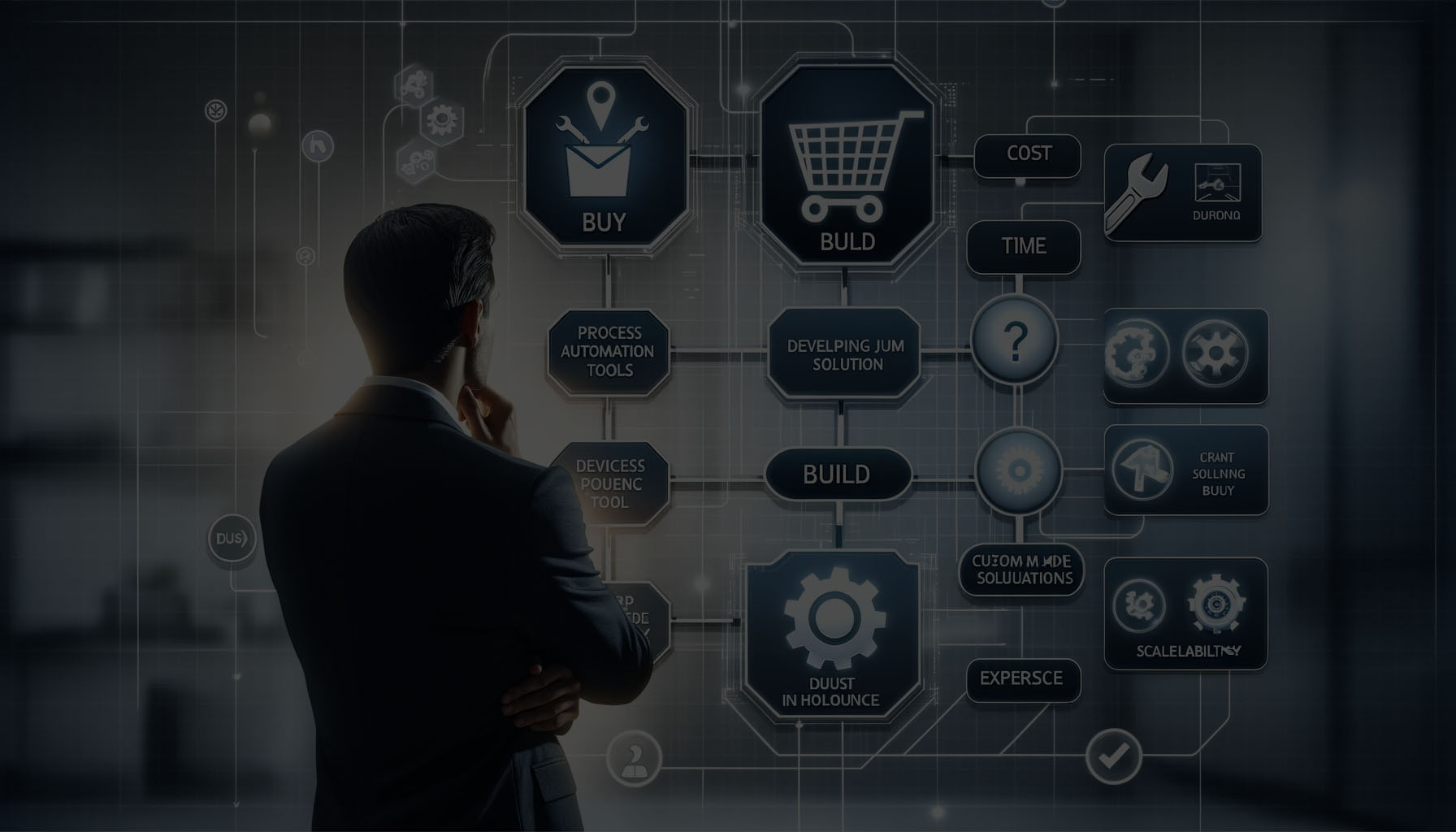In today’s fast-paced business landscape, the need for process automation is more evident than ever. Companies are constantly seeking ways to improve efficiency, reduce errors, and stay competitive. When it comes to process automation, organizations often face a crucial decision: should they buy off-the-shelf solutions or build custom automation tools in-house? This article explores the factors to consider when making this decision, weighing the pros and cons of both approaches, and providing guidance on how to make the right choice for your organization.
Factors to Consider When Choosing between Buying or Building Process Automation
The decision to buy or build process automation hinges on several key factors. To make an informed choice, you should carefully evaluate the following considerations:
1. Problem and Scope of the Project
The journey towards process automation starts with a clear understanding of the problems you want to solve and the scope of the project. Engage with stakeholders across your organization to identify pain points, challenges, and areas where automation can bring significant improvements. Look for repetitive, time-consuming, error-prone tasks that could benefit from automation. Ideally, choose well-defined, rule-based processes with clear inputs, outputs, and decision points, as these are prime candidates for automation.
2. Objectives and Expected Benefits
Define the goals you aim to achieve through process automation. Whether it’s improving efficiency, reducing errors, streamlining workflows, or enhancing customer satisfaction, having well-defined objectives is crucial. Estimate the number of processes to be automated, the required level of integration, and the expected return on investment (ROI). Consider not only initial costs but also the ongoing cost of maintenance and continuous improvement.
3. Resources, Costs, and Time
Assess the availability of resources within your organization. Consider factors such as technical expertise, budget, and project timeline. Building custom applications may require a significant initial investment in terms of time, money, and resources, including development, testing, deployment, and support. Evaluate whether you have the in-house capabilities to handle these aspects or if external expertise is needed.

4. Integration Requirements
Determine the level of integration required with your existing systems and applications. Off-the-shelf solutions vary in their ability to seamlessly integrate with your current infrastructure. Consider whether customization may be necessary to meet your integration requirements and the associated costs and complexities.
5. Technical Assistance and Maintenance Needs
Evaluate the level of support and ongoing maintenance expected for the automation project or application. Determine if your organization can provide internal support or if you prefer to rely on external experts. Ensure that you have access to the necessary expertise to address any issues that may arise during the automation process.
6. Other Potential Risks
Consider additional risks associated with each option. Assess data security and privacy risks, the possibility of vendor lock-in, and the potential for obsolescence of off-the-shelf solutions. It’s essential to anticipate how each choice aligns with your organization’s long-term goals and needs.
When to Buy Off-the-Shelf Solutions
Off-the-shelf solutions are ideal for organizations with standardized IT stacks, simpler processes, and specific departmental needs. They can provide quick solutions to address specific challenges at various stages of your business lifecycle.

Pros and Cons of Building Custom Process Automation Solutions
Advantages
1. Customization
Custom development ensures that your solution aligns perfectly with your organization’s unique requirements and processes, allowing for maximum adaptability and efficiency.
2. Flexibility
Custom applications can be easily updated and modified as your needs change, ensuring ongoing relevance and effectiveness.
3. Competitive Advantage
Custom solutions can provide a competitive edge through differentiation, unique features, and tailored problem-solving. They support process optimization, enhancing efficiency and productivity.
4. Scalability
Custom applications can adapt to your organization’s growth and evolving needs, allowing for seamless expansion or modification.
5. Integration
Custom applications can be fully integrated with your existing systems and processes, streamlining data flow and reducing manual data entry.
6. Alignment with Company Culture
Custom solutions can reflect your organization’s culture, values, and vision, enhancing user adoption and employee engagement.
7. Security
You have full control over security aspects, reducing the risk of potential breaches, and enabling robust security protocols tailored to your organization’s specific needs.
8. In-Depth Analytics and Reporting
Custom applications can collect and analyze data in a way that aligns with your business goals, enabling detailed reports for informed decision-making.
9. Continuous Improvement
Custom solutions support continuous improvement and updates based on user feedback and changing needs.
10. Long-Term Cost Containment
While custom development requires a significant upfront investment, it often leads to long-term cost savings, especially for organizations with specific needs, as you only pay for the features you require.
Disadvantages
1. Higher Costs
Developing custom applications involves substantial initial costs, including development, testing, deployment, and ongoing maintenance.
2. Expertise Requirements
Custom development demands specialized knowledge and skills in automation and development technologies. Training and expertise acquisition may be necessary.
3. Time to Market
Custom development takes time, potentially delaying the implementation of the solution and ROI realization.

When to Build Custom Solutions
Custom solutions are the right choice for organizations with complex processes, specific information system requirements, and a need for maximum customization. They are particularly suited for businesses aiming to optimize their unique workflows and maintain control over their automation initiatives.
Conclusion: Making the Right Choice for Process Automation
The decision to buy or build process automation tools is not one-size-fits-all. It depends on your organization’s specific needs, budget, and resources. By carefully considering the factors discussed in this article, you can make an informed choice that aligns with your business objectives and long-term goals.
Process automation is a transformative technology that can significantly impact your organization’s efficiency and competitiveness. Whether you choose to buy off-the-shelf solutions for quick wins or invest in building custom applications for long-term benefits, the key is to make a decision that suits your unique requirements and positions your organization for success in the evolving digital landscape. Ultimately, the right choice for process automation is the one that helps you achieve your vision, roadmap, and short and long-term objectives.
See how we can help you to automize your business.



